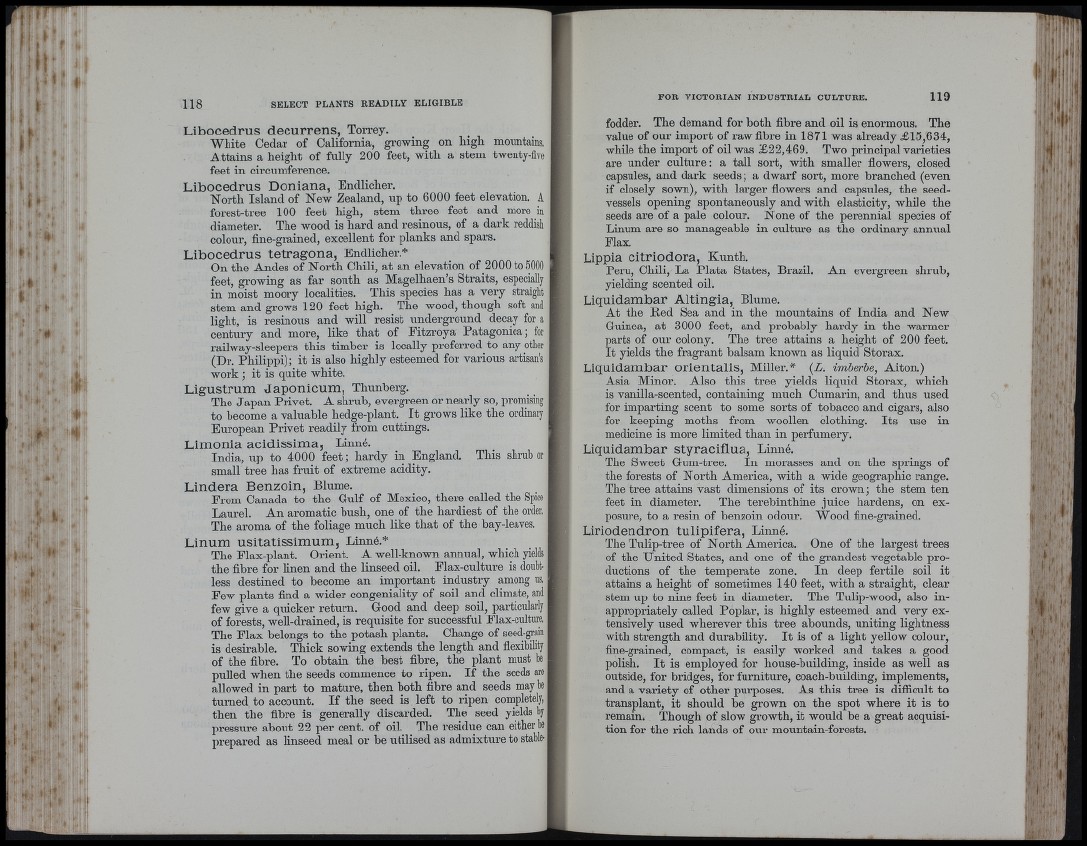
I.
118 SELECT PLANTS READILY ELIGIBLE
Libocedrus decurrens, Torrey.
White Cedar of California, gi’owing on high mountains,
A ttains a height of fully 2 0 0 feet, with a stem twenty-five
feet in circumference.
Libocedrus Doniana, Endlicher.
North Island of New Zealand, up to 6000 feet elevation. A
forest-tree 1 0 0 feet high, stem three feet and more in
diameter. The wood is hard and resinous, of a dark reddisli
colour, fine-grained, excellent for planks and spai’s.
Libocedrus tetragona, Endlicher.*
On the Andes of North Chili, at an elevation of 2000 to 5000
feet, growing as far south as Magelhaen’s Straits, especially
in moist moory localities. This species has a very straight
stem and grows 120 feet high. The wood, though soft and
light, is resinous and will resist underground decay for a
century and more, like that of Fitzroya Patagónica; for
railway-sleepers this timber is locally preferred to any other
(Dr. Philippi); it is also highly esteemed for various artisan’s
work ; it is quite white.
Ligustrum Japonicum, Thunberg.
The Japan Privet. A shrub, evergreen or nearly so, proraising
to become a valuable hedge-plant. I t grows like the ordinary
European Privet readily from cuttings.
Limonia acidissima, Linné.
India, up to 4000 feet ; hardy in England. This shrub or
small tree has fruit of extreme acidity.
Lindera Benzoin, Blume.
Erom Canada to the Gulf of Mexico, there called the Spice
Laurel. An aromatic bush, one of the hardiest of the order,
The aroma of the foliage much like that of the bay-leaves.
Linum usitatissimum, Linné.*
The Elax-plant. Orient. A well-known annual, which yields
the fibre for linen and tbe linseed oil. Elax-cultnre is doubf
less destined to become an important industry among us.
Few plants find a wider congeniality of soil and climate, and
few give a quicker return. Good and deep soil, particularly
of forests, well-drained, is requisite for successful Elax-cultmu
The Elax belongs to tbe potash plants. Change of seed-grain
is desirable. Thick sowing extends the length and flexibility
of the fibre. To obtain the best fibre, the plant must be
pulled when the seeds commence to ripen. I f the seeds are
allowed in part to mature, then both fibre and seeds may be
turned to account. I f the seed is left to ripen completely,
then the fibre is generally discarded. Tbe seed yields by
pressure about 22 per cent, of oil. The residue can either be
prepared as linseed meal or be utilised as admixture to stable-
FOR VICTORIAN INDUSTRIAL CULTURE. 119
fodder. The demand for both fibre and oil is enormous. The
value of our import of raw fibre in 1871 was already £15,634,
while the import of oil was £22,469. Two principal varieties
are under culture: a tall sort, with smaller flowers, closed
capsules, and dark seeds; a dwarf sort, more branched (even
if closely sown), with larger flowers and capsules, the seed-
vessels opening spontaneously and with elasticity, while the
seeds are of a pale colour. None of the perennial species of
Linum are so manageable in culture as the ordinary annual
Flax.
Lippia citriodora, Kunth.
Peru, Chili, La Plata States, Brazil. An evergreen shrub,
yielding scented oil.
Liquidambar Altingia, Blume.
At tbe Bed Sea and in tbe mountains of India and New
Guinea, at 3000 feet, and probably hardy in the warmer
parts of our colony. The tree attains a height of 200 feet.
It yields tbe fragrant balsam known as liquid Storax.
Liquidambar orientalis. Miller.* {L. imberbe, Aiton.)
Asia Minor. Also this tree yields liquid Storax, which
is vanilla-scented, containing much Cnmarin, and thus used
for imparting scent to some sorts of tobacco and cigars, also
for keeping moths from woollen clothing. Its use in
medicine is more limited than in perfumery.
Liquidambar styraciflua, Linné.
The Sweet Gum-tree. In morasses and on the springs of
the forests of North America, with a wide geographic range.
The tree attains vast dimensions of its crown; the stem ten
feet in diameter. The terebinthine juice hardens, on exposure,
to a resin of benzoin odour. Wood fine-grained.
Liriodendron tulipifera, Linné.
The Tnlip-tree of North America. One of the largest trees
of the United States, and one of the grandest vegetable productions
of tbe temperate zone. In deep fertile soil it
attains a height of sometimes 140 feet, with a straight, clear
stem up to nine feet in diameter. The Tulip-wood, also inappropriately
called Poplar, is highly esteemed and very extensively
used wherever this tree abounds, uniting lightness
with strength and durability. I t is of a light yellow colour,
fine-grained, compact, is easily worked and takes a good
polish. I t is employed for house-building, inside as well as
outside, for bridges, for furniture, coacb-building, implements,
and a variety of other pui-poses. As this tree is difficult to
transplant, it should be grown on tbe spot where it is to
remain. Though of slow growth, it would be a great acquisition
for the rich lands of our mountain-forests.
}
\ I
V|,
'IjV"
t
I: ii I
r t
■r
h ■
■ .1 J \
'- ’I